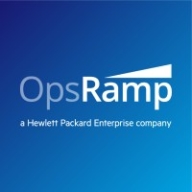

Nagios XI and OpsRamp compete in the IT monitoring solutions category. OpsRamp appears to have the upper hand with its advanced integration of AI features and predictive analysis capabilities.
Features: Nagios XI is an open-source platform known for customization through a wide range of plugins, offering extensive service monitoring and flexible configuration. It incorporates a variety of community-shared plugins, appealing to users with specific monitoring needs. OpsRamp combines monitoring with AI features, providing predictive analysis and alerting capabilities. Its seamless integration with applications like Zendesk and support for hybrid infrastructures are notable. Users appreciate OpsRamp's easy-to-build dashboards and accurate reporting.
Room for Improvement: Nagios XI's setup and configuration process proves challenging, especially for those with limited scripting skills. It currently lacks clustering and failover functionalities, and its reliance on plugins complicates scalability. OpsRamp faces issues with network capabilities and requires improved cloud integration. Its ITSM features need further maturity, and better automation is necessary for patch management and self-service cloud management tools.
Ease of Deployment and Customer Service:Nagios XI performs well in on-premises and hybrid cloud deployments but faces challenges due to complex configuration and timezone-related support issues. Its open-source nature results in a reliance on community forums for support. OpsRamp focuses on public cloud environments, facilitating large-scale deployments with a centralized view. Though customer service is cost-effective, it needs enhancements in response times and ease of deployment.
Pricing and ROI: Nagios XI offers a low initial cost with its free version, appealing through its open-source scalability and low licensing expenses. Despite this, integrating enterprise features can become costly. OpsRamp's moderate pricing is based on resource usage, presenting a cost-effective solution. The licensing model unlocks advanced platform features, promising a strong ROI, particularly in larger deployments.
It is important to stick with available features and provide customers with clear, precise details about what can and cannot be done to avoid anomalies.
I find the licensing model convenient and clear enough, and I have seen a return on investment with OpsRamp.
Having a dedicated firefighter team for each MSP would be beneficial.
If the user interface isn’t presenting data well, it becomes difficult to manage when scaling.
It is very stable.
Many tools have poor user interfaces, making them hard to manage and navigate.
The GUI could be improved. It's a bit too basic.
Technical support should be improved.
We are using the free, open-source version.
The pricing for the Nagios XI product is good and better than other solutions.
it does not strike me as expensive, and the licensing model is clear enough.
Nagios XI simplifies our setup and reduces the time spent configuring monitoring tools.
The alerting system is very effective.
I have utilized OpsRamp's capability for predictive analytics, and it has been important in fostering collaboration between my IT and development teams under DevOps methodologies, where applicable.
| Product | Market Share (%) |
|---|---|
| OpsRamp | 2.7% |
| Nagios XI | 3.5% |
| Other | 93.8% |


| Company Size | Count |
|---|---|
| Small Business | 22 |
| Midsize Enterprise | 17 |
| Large Enterprise | 21 |
| Company Size | Count |
|---|---|
| Small Business | 1 |
| Midsize Enterprise | 3 |
| Large Enterprise | 8 |
Nagios XI provides monitoring of all mission-critical infrastructure components, including applications, services, operating systems, network protocols, systems metrics, and network infrastructure. Third-party add-ons provide tools for monitoring virtually all in-house and external applications, services, and systems.
Nagios XI uses a powerful Core 4 monitoring engine that provides users with the highest levels of server monitoring performance. This high degree of performance enables nearly limitless scalability and monitoring powers.
With Nagios XI, stakeholders can check up on their infrastructure status using the role-based web interface. Sophisticated dashboards enable access to monitoring information and third-party data. Administrators can easily set up permissions so users can only access the infrastructure they are authorized to view.
Nagios XI Benefits and Features
Some of the benefits and top features of using Nagios XI include:
Reviews from Real Users
Nagios XI stands out among its competitors for a number of reasons. Several major ones are its integration options and monitoring abilities, as well as its alerting features.
David P., a senior DevOps engineer at EML Payments Ltd, writes, “We use Nagios as a network discovery tool. We use Nagios to maintain our uptime statistics and to monitor our services. It has allowed us to be much more sophisticated in our monitoring and alerting.”
An IT-OSS manager at a comms service provider notes, “Nagios XI has a custom API feature, and we can expose custom APIs for our integration. This is a great feature.”
OpsRamp is a leading cloud-based digital IT operations management platform. The solution allows your organization to leverage hybrid observability, process automation, and machine learning to modernize IT operations. OpsRamp can handle the speed, scope, and scale of modern IT and can help you drive productivity and business value. In addition, it can help your business manage, monitor, and consolidate your point tools and applications.
OpsRamp Features
OpsRamp has many valuable key features. Some of the most useful ones include:
OpsRamp Benefits
There are many benefits to implementing OpsRamp. Some of the biggest advantages the solution offers include:
We monitor all IT Infrastructure Monitoring reviews to prevent fraudulent reviews and keep review quality high. We do not post reviews by company employees or direct competitors. We validate each review for authenticity via cross-reference with LinkedIn, and personal follow-up with the reviewer when necessary.